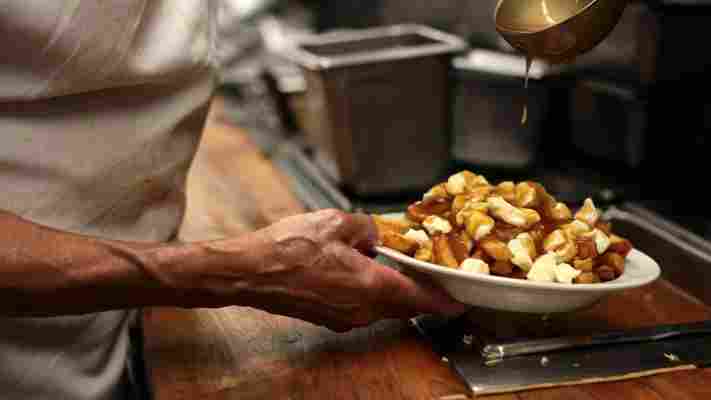Why only Quebec can claim poutine
"It is the unofficial official dish of Canada. In fact, if they could make it look good on a flag, the maple leaf's days might be numbered," Jamie Oliver quipped in an article about making the perfect poutine . As harmless as Oliver's comment appears, it's the perfect example of how a dish that stirs real feelings of heritage and culture in the Canadian province of Quebec may slowly be losing its regional identity.

Whether it's from a busy late-night diner or a quiet countryside cafe, poutine's combination of French fries topped with fresh salty cheese curds and a rich meaty gravy remains a simple, timeless comfort food. Though its unassuming origins lie in the rural dairy strongholds of the Centre-du-Québec region, the popularity of the dish spread to Montreal's cafes and bistros in the 1970s, hit the menus of fast-food giants like Burger King and McDonalds a decade later, and was a nationwide favourite by the early 1990s.

The beloved comfort food poutine is a combination of French fries, cheese curds and a rich meaty gravy (Credit: JML Images/Getty Images)
But tensions around identity are never far from the surface in Canada's only French-speaking province, even when it comes to its most beloved culinary export. From chain restaurants across Canada to street food trucks in Europe and Asia, poutine has travelled far. But rather than the Quebecois fleurdelisé flag, it's the Canadian maple leaf symbol that appears most regularly on menus alongside the dish beyond the province's borders .
The dish should be, ideally, labelled explicitly as a Quebecois dish
It's not only the iconography that confuses its identity. In 2016, US President Barack Obama served Canadian Prime Minister Justin Trudeau poutine at the White House because "we want our Canadian friends to feel at home". Venerable Canadian magazine Maclean's went as far as crowning poutine the country's most iconic dish in a 2017 survey . Whether it's through bold images or carelessly spoken words, the dish's regional heritage is often obscured.
My own first taste of poutine came from the hands of an overworked man helming a food truck amid the relentless hum of downtown Toronto's lunchtime rush. A sweltering summer afternoon in Canada's largest financial district is neither the time nor the place for poutine, but the rich melted cheese and tender yet springy texture left me yearning for more. But I also longed to try the dish in its home province, and some months later found myself braving Montreal's chilly autumn winds on my way to La Banquise , the city's poutine institution.
I pored over the lengthy menu, a 30-strong smorgasbord of deliriously comforting delights. I chose La Savoyarde, a gratuitous mountain of the standard poutine combo generously topped with bacon and onions, plus Swiss cheese and sour cream that began slowly melting the moment it was presented. This was poutine in its most flamboyant form; shamelessly indulgent and profoundly satisfying.

Poutine sellers sometimes represent the dish as broadly Canadian rather than specifically Quebecois (Credit: Portland Press Herald/Getty Images)
But while I revelled in sampling the dish in one of its spiritual homes, my thoughts drifted back to the poutine sellers I'd seen back in Toronto, spots that largely ignored the Quebecois roots of the regional snack food. I wondered if even this humble comfort food couldn't be spared the identity tensions that have dogged Canada for decades. Though some time had passed since the nail-bitingly close sovereignty referendum of 1995, the linguistic and cultural divide between Anglo and French-speaking Canada remains. Many Quebecois don't feel strongly about their Canadian identity, fearing they are always at risk of cultural absorption.
“The dish should be, ideally, labelled explicitly as a Quebecois dish and not a Canadian one to further underscore the cultural context to which it actually belongs,” wrote Nicolas Fabien-Ouellet in his notable 2016 thesis, Poutine Dynamics .
You may also be interested in: • Canada's Christmas tree in a bottle • In search of my French past in Canada • The chef who overcame Canada's Sixties Scoop
And for some, any appropriation is to the detriment of Canadian gastronomy as a whole. "We are diluting Canadian cuisine if we say that regional dishes are national," said Quebec-based writer and restaurant critic Lesley Chesterman. "It's more interesting to say that a dish is Quebecois than to say that it is Canadian. Why not put the 'Quebecois' label on something that is Quebecois?"
I wanted to dig into the origins of poutine to better understand its cultural resonance, and that meant speaking to those in Centre-du-Québec's pastoral heartlands.
Poutine’s origins lie in the rural dairy strongholds of the Centre-du-Québec region (Credit: Perry Mastrovito/Getty Images)
Local historian Guy Raiche of the Société d'Histoire de Warwick traces poutine's roots to the late 1950s in Warwick, a small rural town halfway between Montreal and Quebec City. "It was created in 1957 at the restaurant Café Idéal," he explained. "A customer entered one day and requested that the owner Ferdinand Lachance give him fries and cheese curds together in a paper bag because he was in a rush."
Despite the unusual request, Lachance acquiesced replying, " ça va faire une maudite poutine! " ("that will make a damned mess!").
From these slapdash beginnings, the combination of fries with the region's celebrated cheese became a hit. "We have a lot of cheese products here. It started a bit like that because everybody was coming to the restaurants at the hour where the cheese would be at its most fresh," said Marie-Hélène Beaupré of Tourisme Centre-du-Québec . "So, at 17:00 everybody would go to the restaurants just to have the freshest cheese and freshest fries together." The addition of gravy came a few years later, and it wasn't long before poutine found its way to the cafes and snack bars of Montreal and Quebec City.
But while poutine now can be found dressed up with kimchi, seaweed and even fois gras , during those early years it was looked down upon as a working-class junk food and, at times, a subject of shame. The origins of its name, which translates to "mess" in English, could provide a clue as to why. In Poutine Dynamics, Fabien-Ouellet discusses how "for older generations, the very subject of poutine consumption is often avoided and the dish itself deprecated, often seen as an embarrassing culinary invention."
Fresh salty cheese curds give poutine its signature squeaky texture (Credit: Bouillante/Getty Images)
Even considering the nationwide popularity of the dish, for some, the dish still has the power to evoke painful memories of a time when Quebec was seen as culturally backward by the rest of Canada. Mocked and ridiculed for such an unsophisticated food, a stigma existed around poutine that was difficult to shake.
"I think some people maybe weren't happy to be associated with poutine in the beginning, but now it's in our roots and part of our culture," said Annie Barsalou, co-owner of La Banquise . For her, the reasons for its nationwide popularity aren't complicated: "I think people love poutine simply because it's comforting."
It was always the go-to junk food that no self-respecting parent would ever make at home
In reflecting on his own childhood in Quebec, Montreal chef, restaurateur and TV host Chuck Hughes said, "Growing up, poutine was like a reward. It was always the go-to junk food that no self-respecting parent would ever make at home. It was definitely a guilty pleasure."
Hughes cast aside any unease he had about the dish when he introduced it to an international audience more than a decade ago. In 2009, Hughes appeared on the TV cooking competition Iron Chef America, serving up a playful lobster poutine to the judges. Rather than guilt, he presented the Quebecois dish with a sense of pride.
"It wasn't necessarily meant to impress, but it was more of a dish that represents my culture, my people and where I'm from," said Hughes. "It was like a 'wink wink' to people back home who were watching the show."
Classic poutine is often sold alongside versions topped with an array of decadent ingredients (Credit: spasmik/Getty Images)
Though Hughes's haute cuisine version isn't typical poutine, that appearance on US television may have been the first time many Americans heard of the dish. In the ensuing decade, poutine's popularity has soared. It's now known in the US, across Europe and even in some cities in Asia.
However, from the streets of Prague to market halls in Berlin , it's often still the maple leaf that flies the flag for Quebec's most famous culinary export. And while spreading the joy of poutine and adapting it in vibrant new ways is no bad thing, explicitly labelling it with imagery like the Canadian rather than the Quebecois flag lends credence to accusations of cultural appropriation and "Canadianisation".
But not all global purveyors of poutine feel the need to brand their product with the Canadian red and white.
"We missed poutine and nobody else here was really doing it," said Graham Gartside-Bernier, co-owner of the Blue Caribou Snack Bar in Manchester, UK. Gartside-Bernier and his Quebecois partner Vincent moved from Canada to Graham's native UK and set up Blue Caribou in 2016 with the aim of bringing real Quebecois flavours to a UK audience. With their stand decked out in the blue and white of the fleurdelisé and a menufeaturing the names of their dishes in French, there's no ambiguity about what or where Blue Caribou represent.
From the flag in the logo to their Quebecois maple syrup , Gartside-Bernier wants to stay as true to poutine's origins as possible. "Everything that we do has got Quebec stamped all over it. We try to use real Quebec flavours and infuse some of the history and culture into what we do."
Poutine can be found throughout the world, but its spiritual home remains in Quebec (Credit: David Madison/Getty Images)
With styles and toppings ranging from smoky pastrami to hot Buffalo chicken draped in blue cheese, the Quebecois comfort food has found a new market in Manchester. "We've got our devout customers," said Gartside-Bernier, "But we also get people who are introduced to it for the first time and it's almost like their minds are blown because they can't understand why something so simple – those three ingredients – tastes so good."
As I found out with my own indulgent first bite, poutine's unique melted cheese curd texture is simple yet seductive. But it's also fleeting; a moment in time to savour and move on. Questions of identity and the ownership of poutine's soul, however, endure.
Culinary Roots is a series from BBC Travel connecting to the rare and local foods woven into a place’s heritage.
---
Join more than three million BBC Travel fans by liking us on Facebook , or follow us on Twitter and Instagram .
If you liked this story, sign up for the weekly bbc.com features newsletter called "The Essential List". A handpicked selection of stories from BBC Future, Culture, Worklife and Travel, delivered to your inbox every Friday.




Post a Comment